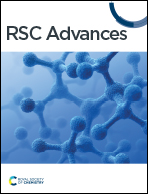Effect of maleic anhydride grafted poly(lactic acid) on rheological behaviors and mechanical performance of poly(lactic acid)/poly(ethylene glycol) (PLA/PEG) blends
Abstract
A series of polylactic acid (PLA)/polyethylene glycol (PEG) blends was prepared by melt blending using PEG as a plasticizer to address the disadvantages of PLA brittleness. PEG can weaken the intermolecular chain interactions of PLA and improve its processing properties. PLA-grafted maleic anhydride (GPLA) was reactively blended with PLA/PEG to obtain a high tenacity PLA/PEG/GPLA blend. GPLA was prepared by melt grafting using diisopropyl peroxide as the initiator and maleic anhydride as the graft. The effects of different PEG molecular weights (1000–10 000 g mol−1) on the properties of PLA/PEG/GPLA blends were investigated. GPLA reacted with PEG1000 (Mw = 1000 g mol−1) to form short PLA branched chains and reacted with PEG10000 (Mw = 10 000 g mol−1) to form a small number of PLA branched chains, which was unconducive to increasing the intermolecular chain entanglement. The branched PLA formed by the reaction between PEG6000 (Mw = 6000 g mol−1) and GPLA had a remarkable effect on increasing intermolecular chain entanglement. The complex viscosity, modulus, and melt strength values of PLA/PEG6000/GPLA blends were relatively large. The elongation at break of the blends reached 526.9%, and the tensile strength was 30.91 MPa. It provides an effective way to prepare PLA materials with excellent comprehensive properties.



 Please wait while we load your content...
Please wait while we load your content...